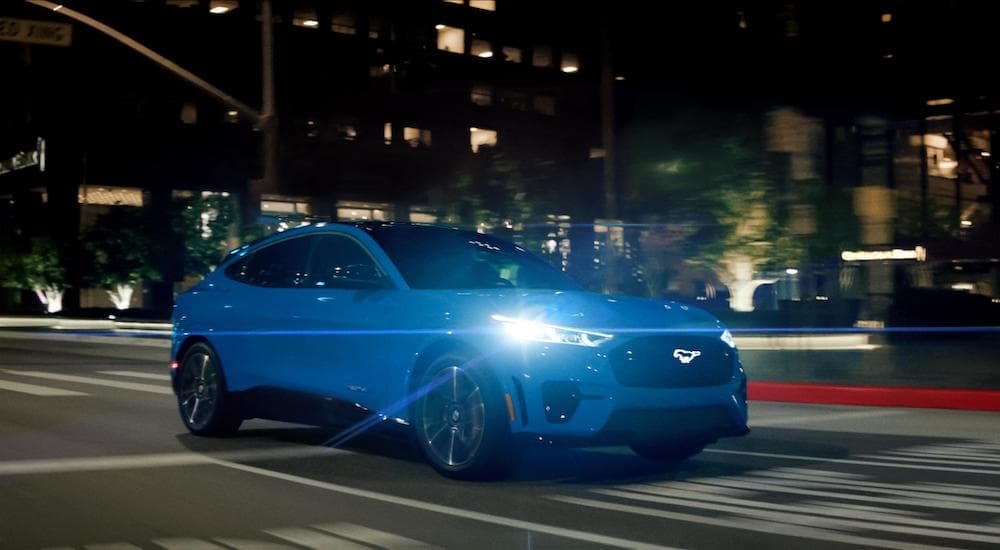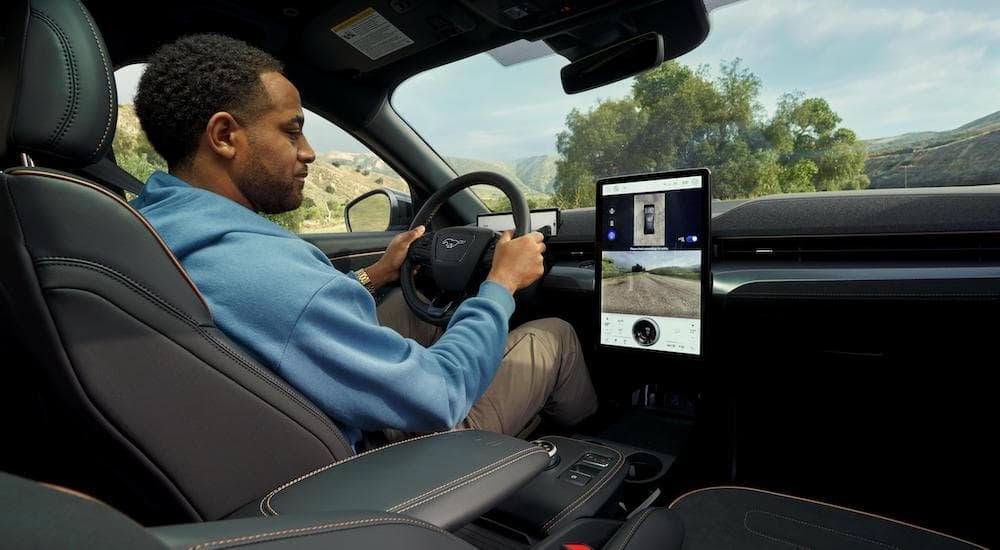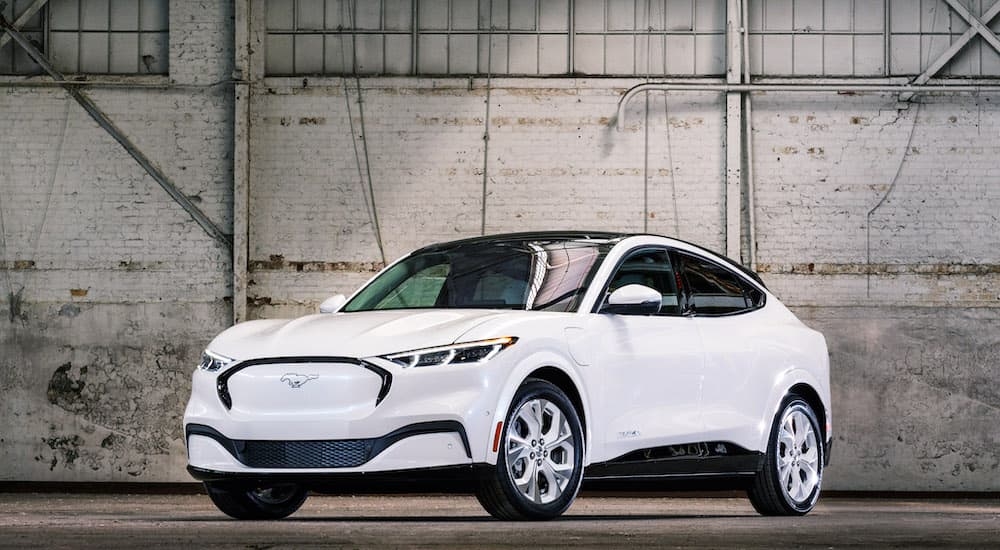To say we’re in a period of automotive upheaval is an understatement. The shift toward an all-electric future is fraught with growing pains, and it’s something we’re seeing across the industry as a lot of brands struggle to figure out what their lineup will look like in the years ahead. For many, it’s a period of slow and awkward adjustments resulting in vehicles that are interesting but that also miss the mark in some key ways.
One noteworthy exception to this, however, is Ford and the Mustang Mach-E, which beautifully combines the legacy of the Mustang name with a sleek new, electrified design. Whether you’re interested in a Ford Mustang Mach-E for sale or you’re simply curious about this remarkable battery electric vehicle (BEV), there’s a lot to take in about it.
One of the best ways we’ve found to fully appreciate what the 2023 Mustang Mach-E has to offer is to look at it beside other models in its class. Specifically, we’re going to look at BEV compact SUVs—those models that are similar in size and with all-electric powertrains. That limits our view a bit, but there are a surprising number of competitors out there, so let’s dig in!
Relishing the Ford Mustang Mach-E
Before looking at what the other guys have to offer, let’s take a moment to check out some of the highlights of the Ford Mustang Mach-E. As we said, this is a compact SUV, which means it has seating inside for up to five passengers across two rows. You get nearly 30 cu.ft. of rear cargo space inside the Mustang Mach-E, with almost 60 cu.ft. of total cargo volume behind the front seats, plus a drainable frunk that works perfectly as a portable cooler. It’s a gorgeously designed vehicle, and that extends to its interior, too, where you’ll find comfortable seating and a stunning 15.5-inch infotainment display in every model.
In terms of performance, you have two battery options and several different configurations for the Mustang Mach-E. The 72-kWh Standard Range battery is what you start with, though a 91-kWh Extended Range battery is available to go further on a single charge. You can also choose either a single motor (for rear-wheel drive) or a dual-motor configuration for electric all-wheel drive (eAWD) that boosts power and performance.
The Standard Range battery with eAWD can go up to 224 miles on a full charge, while the Extended Range battery lets the Mustang Mach-E go up to 312 miles on a full charge when properly configured. For thrill-seekers, the incredible GT trim enjoys 480 hp and 634 lb-ft of instant torque, giving you a pulse-pounding drive every time you hit the road.
Versus the Hyundai IONIQ 5
First up in our comparisons, we have Hyundai’s recent offering in the BEV market, the IONIQ 5. Similar in size to the Mustang Mach-E, the IONIQ 5 also has two batteries available, but the standard one is only a 58-kWh battery pack, while the Long Range one is a 77.4-kWh battery—barely more powerful than the Mach-E’s standard.
The starting single-motor model delivers 168 hp and 258 lb-ft of torque, which falls well short of the Mustang Mach-E’s standard 266 hp and 317 lb-ft of torque. Even if you go for the most powerful version of the IONIQ 5, you get just 320 hp and 446 lb-ft of torque, coming up quite wanting compared to Ford’s model.
Versus the Kia EV6
Next up, Kia checks in with a similar BEV that has one of the most powerful configurations available in this segment—and yet, its batteries are the same as what we see in the Hyundai IONIQ; it even has the same standard 167 hp and 258 lb-ft of torque as Hyundai’s model. Fortunately, Kia offers an improved top-end option with the EV6 GT-Line that delivers 576 hp and 545 lb-ft of torque. This gives the Mustang Mach-E a fair bit of competition, and we love to see so much power from a brand like Kia.
Versus the Nissan ARIYA
The Nissan ARIYA is another impressive competitor, though it falls short of what Ford delivers. Here, again, we have two battery options—a standard 63-kWh battery and an enhanced 87-kWh battery—and you can see they both fail to match what Ford offers. At its best, the ARIYA gets 389 hp and 442 lb-ft of torque from a dual motor setup, which isn’t nearly as powerful as the Mustang Mach-E, though it can come close to the Mach-E’s range with up to 304 miles estimated from its most efficient configuration.
Versus the Subaru Solterra
Subaru has decided to keep its BEV compact SUV quite accessible, but they’ve sacrificed a lot of power and flexibility in the process. The Solterra has a single setup—a 71.4-kWh battery with a pair of motors—which sounds pretty good at first, but they only deliver 215 hp and 249 lb-ft of torque. That falls short of the Mustang Mach-E’s starting configuration, and it’s not even on the same page as what you can get with the Mach-E GT. With just 228 miles of range from a full charge, the Solterra simply cannot compete with the other vehicles in this category.
Versus the Tesla Model Y
You didn’t think we’d forget about Tesla, did you? The big dog in the BEV game—Tesla’s Model Y—is a direct competitor to the Mustang Mach-E, and it delivers in some major ways. You can get single-motor as well as dual-motor configurations for the Model Y, with different setups for a focus on either range or performance.
This is the only model in its class that potentially has a greater range than the Mustang Mach-E, topping out at an estimated 330 miles when properly configured, and its 15.0-inch screen comes close to what Ford offers (as every other model here has a 12.0-inch infotainment display). As you might expect, we’ll stick with the Mustang Mach-E, but Tesla comes the closest to swaying us on that decision.
Versus the Toyota bZ4X
Next up, we have another model that should be a strong contender but ends up falling short against the Mustang Mach-E. The Toyota bZ4X is offered with either a single motor or in a dual-motor configuration, and while they each have a different battery pack, the difference there isn’t noteworthy. The single-motor setup delivers 201 hp and 196 lb-ft of torque while going for two motors pushes that slightly to 214 hp and 248 lb-ft of torque. With a maximum of 252 miles of range from a full charge, the bZ4X simply can’t compete with what Ford offers.
Versus the Volkswagen ID.4
Finally, there’s Volkswagen and their most recent offering, the all-electric ID.4. With a starting 62-kWh battery and single motor, the ID.4 isn’t very impressive, but upgrading to an available 82-kWh battery and dual-motor setup helps improve things a bit. With this configuration, the ID.4 comes to life with 302 hp and 339 lb-ft of torque, which is respectable. The maximum range of up to 275 miles helps the ID.4 surpass options like the bZ4X and Solterra, but it still gets left behind by Ford’s SUV.
So, Which EV Comes Out on Top?
Looking at these numbers, it’s pretty clear that the Mustang Mach-E has very little real competition. This is true in terms of pure performance and power, as well as the kind of range it has to offer and even interior features like its massive infotainment display. It’s not surprising that the Tesla Model Y is the closest rival, which reinforces how well Ford understands the BEV market and has designed the Mustang Mach-E to dominate this growing segment.
As a Ford dealership, it’s probably no surprise that we prefer the Mustang Mach-E over a Tesla, but even outside of our own preferences, there’s something to be said for the legacy of amazing vehicles Ford has established for more than a century. In that respect, Tesla has a long way to go if it ever wants to compete.


